Snapshot on Crime
Posted on: November 12th, 2013 by Smart on Crime
I live a busy life. Like many of you, I wear a lot of hats in our community. I have a really hard time saying ‘no’ to people, causes, and commitments that intrigue me.
Which is how I found myself parked in gridlock on Toronto’s busy Lakeshore Drive one drizzly, grey, and miserable November evening … trying to make my way home to Waterloo from a series of meetings in the downtown. As usual, I was late. Also, as usual, I had been parenting my youngest son from afar via BBM … What’s up? Good day? How was football practice? Have you eaten? What homework do you have? Did you put the dog out? Always ending with: I love you, Peter. I love you too, Ma.
Peter’s responses were predictable. At 17, he was happy to have the house to himself. Sitting in my car, I could picture him in my mind: He came home from school, dumped his gear behind the sofa, gave the dog some love, headed straight to the fridge, and then upstairs to have a hot shower. He was likely comfortably lounging in our family room, making his way through the multitude of sports channels on cable. I knew he was safe, warm, fed, and had his beloved furry companion by his side.
As I inched my way towards a grey and dreary intersection on Lakeshore, I spotted the inevitable dance of captive motorists being courted by ‘squeegee kids’ with their proactive offers of clean windshields. Despite a 1999 provincial law that outlaws it and recent City of Toronto calls (2011) to come down hard on panhandlers, squeegeeing is the norm in Toronto: Cars stop at a light and nervous drivers avert their eyes or uncomfortably acknowledge the young people who approach their cars. I’ve been in this dance before, always leaving the dance floor with a sense of unease and emptiness.
I did the quick calculations. I was going to be the first car in line at the intersection. I had some spare change in the car, but I also needed a coffee. It was raining. I didn’t need my windows cleaned. I turned the radio up and did my best to pretend that I was an island.
I pulled up to the red light. Thoughts of Peter passed through my head: I hope he’s doing his homework.
I looked up and saw a young man standing on the boulevard. He looked nervous. He also looked wet and cold. His green eyes instantly reminded me of Peter. What if?
I couldn’t stop myself. I rolled down my window and called him over. His name was Joel. He was 17. I told him that I knew that. We chatted. I bypassed the spare change, reached into my designer handbag to open my designer wallet and gave him paper money. I gave him my business card. I asked him to call his mom. I got honked at. He very quietly thanked me. He packed up his backpack and crossed the street in front of me. He waved, walked, and then ran back to my window. He thanked me again and told me that he was going to get something to eat and that he would call his mom.
I turned off my radio. I wondered if Joel would follow through. I knew the chances were slim, but I had to believe that maybe, just maybe he would. I knew that many would ridicule me for thinking so. I had to hope.
I headed home to my son, who was still safe, warm, fed, and had his beloved furry companion by his side. I thought about my busy life and wondered if my work – the politics, the teaching, the community building, and the volunteer work – was helping or hindering my own social fabric. I love you Peter.
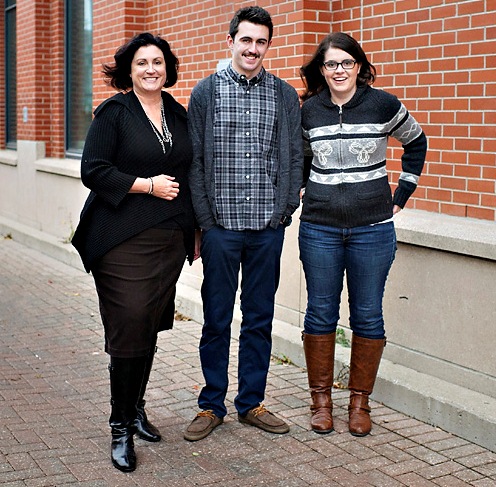
Karen Scian and her “Social Fabric”
Author: Karen Scian is a Waterloo City Councillor and Chair of the Finance and Strategic Planning Committee at the City of Waterloo. She holds a Bachelor of Science from the University of Waterloo, a Bachelor of Education from Western, and a Master of Arts in Leadership. Karen has spearheaded Waterloo’s commitment to open and transparent government by hosting innovative online events such as an All-Access Budget Townhall, Twitter Townhalls, and working with the community to revamp the City of Waterloo’s Citizen Committees. Karen is an instructor at Conestoga College’s School of Business and Hospitality, teaching Civic Engagement, Urban Studies, Ethics, and Sustainability Management to tomorrow’s leaders. She is also a trustee of the Waterloo Public Library and the Chair of the Board of Directors for Community Justice Initiatives (CJI), a local restorative justice organization.
Posted on: October 30th, 2013 by Waterloo Region Crime Prevention Council
Thanks to the Waterloo Region Crime Prevention Council for their 2012 report A Snapshot in Time: The Root Causes of Crime in Waterloo Region. The report has been a conversation starter for important dialogue in our community. It shines a spotlight on the root causes of crime locally, and uses calls to our Centre’s 24 Hour Crisis and Support Line as a data point related to local sexualized crimes.
We know that securing data about the prevalence of sexual violence can be challenging; sexual assault is the most under-reported violent crime in Canada. In 2012 the Waterloo Regional Police Service received 558 sexual assault reports. While that number itself is alarming, we only begin to understand the magnitude of sexualized crimes in our community when we consider that less than 10% of sexual assaults are reported to police nationally. Therefore, pulling data from a number of sources enhances our understanding of this complex issue.
Over the years, our crisis call numbers have fluctuated. In the last decade, there’s been a trend towards a moderate decline in the number of calls received, but the overall demand for our services has increased significantly. The explanation for this is simple; historically we provided more basic information related to services and supports on our crisis line. With much of that information now readily available online, the calls we most often receive today are supportive in nature or focused on crisis intervention.
With new ways of communicating emerging, our Centre has begun to explore the option of incorporating live online support into our crisis and support services.
Who else is involved in addressing this issue?
Awareness of the prevalence and impact of sexual violence has begun to increase regionally, thanks to the commitment of community partners to work in a spirit of collaboration.
In 2007, our community began to mobilize on this issue. A number of service providers formed a network which evolved into the Sexual Assault Response Team of Waterloo Region (SART). SART is now a community coordinating committee made up of 18 partner agencies from the criminal justice sector, the health sector, and the social services sector.
In 2012, SART launched a community protocol for responding to sexual assault in our region. The first such protocol of its kind in Waterloo Region, its purpose is to give service providers a broader foundation for the work they do. The protocol establishes a common understanding and framework for the provision of services to survivors of sexual violence, enabling greater coordination and collaboration between community partners.
What should be done?
Sexual violence impacts people of every age and cultural background, and has devastating impacts on individuals, families and communities. Every survivor, regardless of gender, deserves access to specialized support services in our community to promote healing.
As a region and more broadly, we need to balance our investment in support services for survivors of sexual violence and with public education campaigns aimed at prevention. We have consistently seen that early-intervention and prevention are necessary and cost effective.
It is important to understand, however, that sexual violence is primarily perpetrated by men, against women, children, and trans people.
According to a 2006 Statistics Canada report, more than one in three women will experience some form of sexual assault in her adult lifetime (p24). Over 93% of reported adult sexual assault victims are female, while 97% of those accused are male (p37).
As such, we need to consider social constructions of gender when looking at the prevention of sexualized crimes. Sexual violence is about power and control, not sexual desire. It is about aggressively dominating someone else.
This knowledge was the impetus behind the creation our Male Allies Against Sexual Violence (MAASV) program in 2008. MAASV is a unique public education program focused on working with men in positions to influence male youth (such as coaches, faith leaders, teachers, and fathers). The program explores how popular conceptions of masculinity can limit men’s freedoms and harm others. MAASV encourages young men to treat women with fairness, equality and respect and to stand up and speak out on gendered violence. (More information on MAASV can be found here: www.MaleAllies.org)
Sexual violence is pervasive, but it’s not inevitable. Through public education, social change is possible. A better future exists for our daughters and our sons.
 Author: Sara Casselman is the Public Relations & Operations Manager at the Sexual Assault Support Centre of Waterloo Region. In the anti-violence against women sector for more than a decade, Sara has been recognized provincially as a Leading Women, Building Communities Award Recipient (2011) and was featured in The Record’s 40 under 40 (2012).
Author: Sara Casselman is the Public Relations & Operations Manager at the Sexual Assault Support Centre of Waterloo Region. In the anti-violence against women sector for more than a decade, Sara has been recognized provincially as a Leading Women, Building Communities Award Recipient (2011) and was featured in The Record’s 40 under 40 (2012).
Posted on: October 30th, 2013 by Waterloo Region Crime Prevention Council
Only one in eight sexual assaults in Canada is reported to police. The Sexual Assault Support Centre of Waterloo Region calls for service provides an additional data point to examine sexual assault rates in Waterloo Region. However, this number should be viewed with caution as it fluctuates based on promotion of the crisis line and provides only total number of calls.
The Statistics
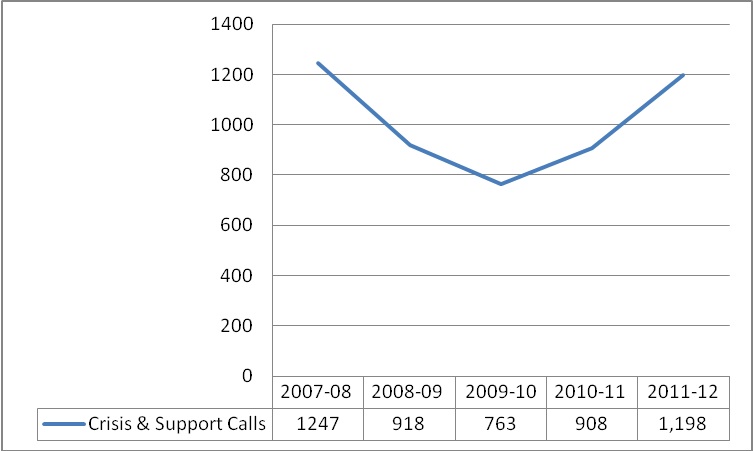
Data Source: Sexual Assault Support Centre of Waterloo Region, Annual Report
Story Behind the Numbers
The Sexual Assault Support Centre of Waterloo Region calls for service have varied considerably since 2007. In the past year there has not been a noticeable increase in the number of calls to the crisis line. In 2012 there was no wait list for men but the wait list for counselling services for women reached an all time high of 40 despite an additional part time counsellor and reducing the number of sessions for some clients. This decrease in counselling availability is creating hardships for victims and may be one reason behind the increase in calls to the crisis line rather than indicative of an increase in sexual assaults.
Read the Community Response:
Posted on: October 15th, 2013 by Smart on Crime
Surprise!! Surprise!! “Length of involvement in schooling significantly impacts participation in criminal activity”, reports the recently released Snapshot on Crime: Root Causes of Crime in Waterloo Region. It is good to have the statistical evidence to corroborate what we already know as parents, teachers, and concerned citizens.
To reframe, length of involvement in schooling increases positive life outcomes for youth. High school graduation and access to post secondary education enhances socioeconomic status in adulthood regardless of growing up in a low income family, parents’ level of education or single parent household. Good news. Although, being born poor sucks, it is not a life sentence. Education however is a big deal and exclusion from it puts you firmly on the school to jail pipeline. Education is the great leveler only if you have it, a child denied this basic human right is hurt for life and community safety is impacted. Access to post secondary education reduces the likelihood of adult criminality, increases employability, ability to stay employed and overall socio economic status. Access to education is a matter of equity and social justice, therefore addressing systemic exclusion and disenfranchisement is crucial.
This is nothing new. The Ontario Royal Commission on Learning and the Review of the Roots of Youth Violence report all decried non inclusive curriculum and recommended schools that reflect minorities and policy changes to address lack of engagement and under achievement of young males, black males, in particular. If black boys face more exclusion from the school system, youth who drop out of school are at higher risk for criminality. Black males are overrepresented in the criminal justice system; it then becomes imperative to challenge our beliefs about black boys being inherently criminal. Being young is a not a bad thing. I have yet to meet any person who was never young once. Being a male child is not bad either and there are communities where people go to any length just to have a male child. Being black is no disaster despite the media characterization of Black masculinity. But still, black males are more often the targets of physical aggression, racism, criminality and criminal victimization.
The African community always knew this. Ten years ago, we initiated an after school homework support program to promote school retention, graduation, equitable access and participation. The homework club provides a safe space where any minority child can feel at home to receive help right where they are at and develop the confidence that facilitates integration into the school system. Our neighbors in Toronto successfully advocated for Africentric schools and now have three, amid fierce debates on both sides. I do not intend to spark debates about segregation or integration. Both are not mutually exclusive.
Through our homework program, we work to mitigate the gaps in the mainstream schools. We provide culturally relevant books, resources and instructional materials that honor African and indigenous orality. We connect youth with strong black role models through career talks, job shadow and motivational talks. We immerse our volunteers, white and black, in the culture and life of the youth. Many volunteers come in wanting to help the kids, but they tell us when they leave (some never leave) that they are the ones helped significantly. Many of them want to be teachers and we gladly provide them with reference letters to get into teachers college. We also organize a parent forum to encourage parents to be their child’s best advocate, to understand the assumptions behind the streaming of students that can result in some youth not having the courses required for post secondary education which hinders their ability to maximize their potential and can permanently alter their life trajectories.
Waterloo region is now the 7th top destination for new immigrants and refugees. We cannot reverse the inflow of immigrants as immigration is Canada’s lifeline in the absence of a replacement population. We could admit only people who are not 15-24, male or black but, 20-somethings tend to settle down and have cute little babies, who soon become teenagers. What if we as a community ensured teachers are trained to recognize the world views and assumptions underlying the fear of big tall black boy children? What if teachers, police and other service providers re-examined our social construction of the black male child? Are there things Waterloo Region can learn from Toronto’s Africentric schools about how to adapt and integrate African, indigenous epistemology and pedagogical practices into mainstream schools so that we can better engage young black men? Opponents of Africentric schools describe them as temporary, not cost effective solutions and appeal to our Canadian ideals of cohesion and multiculturalism. I do not agree with either segregation or integration but cohesion and multiculturalism are myths if they exclude some and attempt to promote assimilation under the guise of integration.
Our homework club struggles for lack of funds but the reason it continues year after year is because the children keep coming back for the acceptance, respect, honor and understanding they receive there.
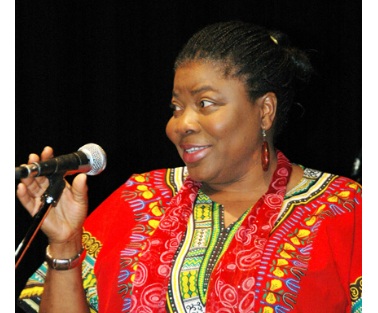
Funke Oba
Author: Funke Oba is the immediate past president of the African Canadian Association of Waterloo Region & Area. Funke teaches social work, is a diversity trainer/consultant and community based researcher with a focus on social justice, equity and social construction of complex phenomena.
Find more community responses from colleague’s in Waterloo Region who also work with young men:
Posted on: October 10th, 2013 by Smart on Crime
The Snapshot in Time: Root Causes of Crime in Waterloo region data on Young Males 15 – 24, by itself, is good information to have but I don’t think that an increase in the population of males aged 15-24 is any reason for alarm. The data clearly shows that the rise in the number of males aged 15-24 across the Region, as a percentage of the population, is holding steady at 7.2% to 7.4%. We also know that the vast majority of youth crime is being committed by a small number of young offenders. With this information, it gives us sense of size and scope youth male crime/victimization. As a community, we should be taking a strategic/focused approach, first to determine what the root causes of crime are as it relates to this cohort. Secondly, what are some of the best/promising practises that can be done prevent young males from being involved in crime and being victims of crime in the first place.
inREACH, a youth street gang prevention project, is an initiative that is designed to work with young men and women who are involved or at risk of being involved with gangs. inREACH is comprised of two program phases, Community Treatment & Community Mobilization. The Community Treatment phase provides 1-on-1 support in areas of mental health, addictions, employment and overall case management. 94.2% of the participants in the Treatment phase are male with the average age being 18.7 years old, with risk factors such as gang involvement, severe addictions, criminal justice involvement and living/lived in care, it is clear that inREACH is a program that has found away to connect with some of the most at risk male youth in our community. The Community Mobilization phase, happens in four communities through out the region and is focused on prevention. Youth Workers engage youth in these communities by finding out what there strengths/interests are, working with the youth to develop the programs and lastly, having the youth play a key role in the delivery of these programs and having a say in any key decisions about the programs. inREACH has managed to be successful for several reasons. inREACH a multi-disciplinary project, that provides client centred, wrap-around supports to young people that we see as assets to our community and having more then just deficits. inREACH is a collaborative project and all of our community partners are fully engaged in working to address the issue of youth gangs in our community.
There is a lot more that can and should be done. I think that Federal, Provincial , Municipal governments and funding organizations should be focused and work collaboratively to support and enhance all of the work that is being done front line to address the issue of youth gangs, male youth violence & victimization. The majority of inREACH program participants were male, from single parent homes, unemployed and already involved with the criminal justice system. If we use a prevention lens, we know that these youth didn’t just wake up one day with all of these risk factors. They have lived and been exposed to risks most of their young life, so participation in a gang is just the symptom of deeper more complex issues. We need programs that aren’t cookie cutter and pre packaged, we need to develop, support and enhance programs that take a holistic long term approach to supporting our most at risk youth. At the end of the day, they are all of our youth and we have a collective responsibility to ensure that they stay safe, not become criminally involved and are also supported so they can become potential that is fully realized.
Author: Rohan Thompson is the Project Manager for inREACH and staff of the Waterloo Region Crime Prevention Council. inREACH is a collaborative, multi-disciplinary program designed to intervene/prevent gang involved or gang vulnerable youth from being involved in gang activity or exiting their gang. Rohan has been involved in working with at-risk youth for over 15 years. He is an avid football fan and is a proud supporter of Wilfrid Laurier Football.
Find more community responses from colleague’s in Waterloo Region who also work with young men:
Posted on: October 8th, 2013 by Waterloo Region Crime Prevention Council
Young males commit most violent crimes in Canada and they are at a higher risk of being a victim of crime. Young males are more likely than other age and gender cohorts to be involved in petty crime such as vandalism and graffiti. As such, the number of males aged 15 to 24 in a community is likely to have an impact on the crime rate. The chart below measures the absolute number of males 15 to 24 living in the Waterloo Region and the percentage of the overall population made up of males 15 to 24.
The Statistics
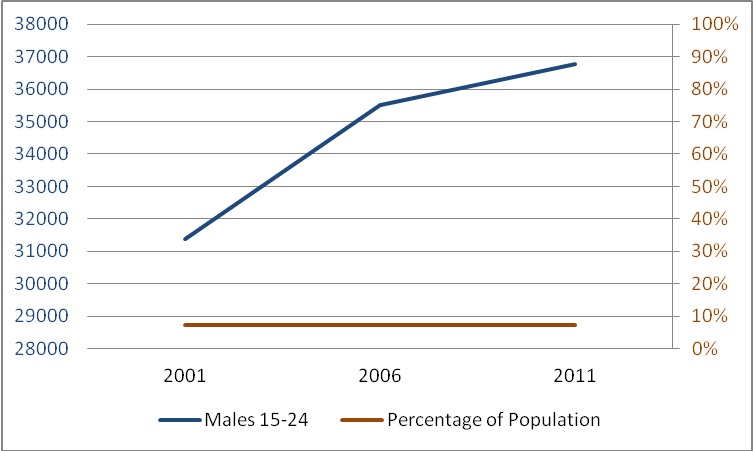
Date Source: Statistics Canada, Census (Released Every Five Years)
The Story Behind the Numbers
The number of males in Waterloo Region, aged 15 to 24, is slowly increasing. However, this increase is currently similar to the increase in the overall population in Waterloo Region. Therefore the percentage of the male population 15 to 24 is remaining steady at between 7.2% and 7.4%.
Read the Community Responses:
Posted on: October 8th, 2013 by Smart on Crime
That was my initial reaction when I read the report, “Snapshot in Time: The Root causes of Crime in Waterloo Region”, and especially the information related to Males 15-24 and the following page that talks about youth unemployment and the fact that those things combined with high levels of alcohol consumption, “it is believed to cause an increase in the homicide rate”. Sometimes it just seems that research doesn’t reveal anything in the way of new information but only serves to confirm what have been long held beliefs by members of our community. It doesn’t make the information any less useful to us and in fact it is important information to guide and direct actions we can take to address these specific issues related to the criminal activities of males 15-24 in our community.
Ray of Hope operates Secure and Open custody facilities on behalf of the Province of Ontario for young men aged 13-17 and in the course of any given year we will serve a few hundred young men. Some of them may spend most of their teenage years returning to our care because of their ongoing conflict with the law and as the report suggests conflict with their peers. For many they have not learned the social skills required to manage their anger in a socially acceptable manner. Unlike most adults who learn constructive ways to deal with conflict, or can afford to have lawyers argue for them, young men tend to be impulsive and find the quickest and easiest way to deal with someone they are having trouble with, which generally relates to some type of punch to the face and escalating violence.
It also comes as no surprise that alcohol or drug use may also contribute to criminal behaviour. Ray of Hope also operates a variety of Youth Addiction Treatment programs in the community and there are a number of similarities between the youth we serve in these programs and the youth engaged in our justice programs. The majority of youth entering our addictions treatment programs already have some type of probation orders from the court system related to previous behaviour, but they have not gone far enough to have landed in custody. The majority of youth in our custody programs have substance abuse problems with drugs or alcohol that are related to their crime. For some, they were involved in robberies or break and enter crimes to fund their drug habit, while others committed their crimes while intoxicated or high.
I don’t think that anything I have stated should come as a shock to anyone reading this blog. It is kind of how life is in any community and it has been this way for years. The question we have to ask ourselves is, “can we do anything to change this”? In their report, “Review of the Roots of Youth Violence (2008)”, The Honourable Roy McMurtry and Dr. Alvin Curling identified the following as contributing factors to youth violence:
- Poverty,
- Racism,
- Community Design,
- Education System,
- Family Issues,
- Health,
- Lack of a Youth Voice,
- Lack of Economic Opportunity, and
- Issues in the Justice System
Even without delving into any of the details of the report it is evident that the issue is extremely complex and that no single simple solution can possibly resolve this situation for our community. As a single issue, something like poverty is a huge challenge for our community and seems to be constantly in the news. But there seems to be little political will to really address the issue and find the resources it will take to minimize the impact of poverty let alone eliminate it. The challenges of system change seem to be too overwhelming and yet if we can bring about some systemic changes the impact could be transformative.
But maybe more can be accomplished by focusing on individuals. Over the past few years the Ministry of Children and Youth Services, Youth Justice Services has introduced a concept entitled, “Relationship Custody” to both direct run and transfer payment agencies. The idea behind this concept is that staff are not to be primarily concerned with guarding youth in our facilities but with building relationships with them and trying to encourage them in making better choices for their lives in the future. I believe that Ray of Hope has operated with this type of philosophy from its very beginning and we are always looking for ways to connect with youth and provide them with the support they need to keep them from reoffending.
At a recent staff meeting one of our staff shared about a young man who had spent some time in one of our custody programs in his early teens. He was still struggling with a number of things so a friend suggested he connect with one of our reintegration staff. After meeting with this youth and exploring his life situation, the youth agreed to enter one of our addiction treatment programs. After successfully working through this program he has now enrolled in our Youth Employment program where he is gaining specific life skills and job skills to help him take control of his future. We may not have transformed the system, but this one young man’s life is being transformed.
The challenge is to try and work at both the system and with the individual and then maybe at sometime in the future the percentage of young males 15-24 in our community may prove to be an indicator of a positive healthy community rather than indicator of violent crime.
 Author: Harry Whyte
Author: Harry Whyte
For the past 5 years Harry Whyte has served as the CEO of Ray of Hope Inc, a local agency that provides support to youth in the areas of Justice, Employment and Addictions, along with the Ray of Hope Community Centre that provides support to people impacted by poverty. Harry and his wife Lois were also the parents of 4 boys, now in their late 20’s and 30’s and so has some firsthand experiences with the challenges faced by young men and their families.
Find more community responses from colleague’s in Waterloo Region who also work with young men:
Posted on: September 17th, 2013 by Waterloo Region Crime Prevention Council
The length of involvement in schooling significantly impacts participation in criminal activity and the probability of incarceration. The table below tracks the percentage of residents in the Kitchener-Cambridge-Waterloo Census Metropolitan Area that do not have a high school diploma.
Data Source: Statistics Canada, Census (Released every five years)
Story Behind the Numbers
In 2006, 23.8% of residents in the Kitchener-Cambridge-Waterloo CMA did not have a high school diploma. This is the exact same as the Ontario provincial average and slightly above the Canada average of 23.4%. However, when the results are examined for individuals under the age of 35, the Waterloo Region has more residents without a high school diploma than the Provincial average. This is significant because individuals under the age of 35 are at the highest risk of participating in criminal activity.
Read the Community Responses
Posted on: September 17th, 2013 by Smart on Crime
It is no surprise that the length of involvement in schooling significantly impacts participation in criminal activity and the probability of incarceration, as found in Snapshot in Time: Root Causes of Crime in Waterloo Region. In fact, this has been well-known in the education sector for many years – which explains the great lengths to which school boards go in mitigating against this problem.
As part of the Student Success Learning to 18 Strategy — through the Re-engagement (12 & 12+) Initiative – school boards contact students who have either left school or have not been attending to re-engage them in their studies to complete their Ontario Secondary School Diploma (OSSD). Funding is provided to the boards to support programs for these students once they return and in Waterloo Region’s Catholic Schools we dedicate a significant amount of staff time to, first, actually locating the whereabouts of these students and then helping them complete their required volunteer hours and/or registered them at our St. Louis Adult Learning & Continuing Education Centres or their home secondary school to accumulate credits toward the OSSD.
The tracking of all of our in-risk students (Grade 9 to those that have left our system without an OSSD) is reported to the Ministry of Education along with other student success tracking data through “Taking Stock” reports. These reports outline the following:
- how many students our schools are tracking that are in-risk;
- are these students attached to a caring adult;
- was their timetable individualized;
- are they getting advice on pathways planning;
- has a strengths profile been created for the student.
Our own internal tracking for students who have left our system without an OSSD looks at:
- number of students contacted;
- did they register for courses, how many;
- how many credits did they accumulate.
In addition to the above some key initiatives are in place to meet the needs of all of our students on their way to successful completion of the OSSD.
- Specialist High Skills Majors allow students to focus on a future career through a bundle of classroom courses, workplace experiences and sector certifications
- Expansion of Cooperative Education allows students to count this hands-on learning towards two compulsory high school credits
- E-Learning provides students with online courses and allows teachers to share resources across the province
- Dual Credits count toward a student’s high school diploma as well as a college certificate, diploma or apprenticeship certification
- Credit rescue programs intervene prior to a student experiencing failure in a course
- Credit recovery programs allow students who have failed a course to only repeat expectations where they have been unsuccessful rather than redoing the whole course
- Supervised Alternative Learning programs allow students to work full-time, get mental health supports, volunteer hours and accumulate credits
So…when it comes to playing our role in reducing the number of local residents without a high school diploma you can rest assured Waterloo Region’s Catholic Schools are front and centre in closing the gap.
Author: David DeSantis is the Superintendent of Learning for the Waterloo Catholic District School Board and responsible for Student Success, Secondary Schools, St. Mary’s FOS, Leadership Development and Succession and 21st Century Teaching and Learning.
Posted on: September 10th, 2013 by Waterloo Region Crime Prevention Council
You might have noticed it in the title… the operative word being “early”. Every three years Senior Kindergarten teachers evaluate their students using the Early Development Instrument. This tool provides scores on a number of factors, two of which directly relate to crime prevention. Social competence measures a child’s interactions with others, ability to control their own behaviour, and cooperation with others. Emotional maturity measures a child’s ability for impulsivity control, ability to deal with feelings, and empathy for others. The percentage of children scoring low on these indices is noteworthy because antisocial behaviour among children is associated with an increased risk of persistent delinquency and criminal involvement later in life
The Statistics
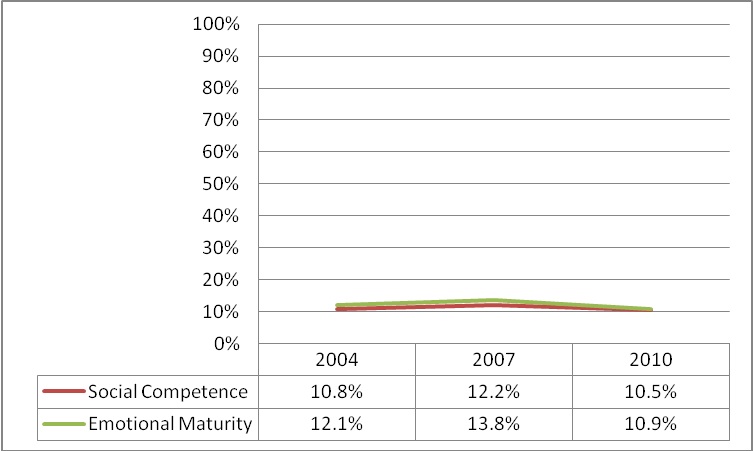 Data Source: Ontario Early Years Centre, A Community Fit for Children Report (Released Every Three Years)
Data Source: Ontario Early Years Centre, A Community Fit for Children Report (Released Every Three Years)
The Story Behind the Numbers
The percentage of children scoring low on the social competence and emotional maturity index declined from 2007 to 2010. However, despite the improvement Waterloo Region did not score as well as Ontario in 2011 which had 9.3% of children score low in social competence. Waterloo Region was also lower than Ontario, at 10.3%, on emotional maturity but this difference was not statistically significant. These numbers suggest that prevention opportunities exist through a focus on improving children’s emotional and social readiness for school.
Read the Community Responses:


 Author: Sara Casselman is the Public Relations & Operations Manager at the
Author: Sara Casselman is the Public Relations & Operations Manager at the 


 Author: Harry Whyte
Author: Harry Whyte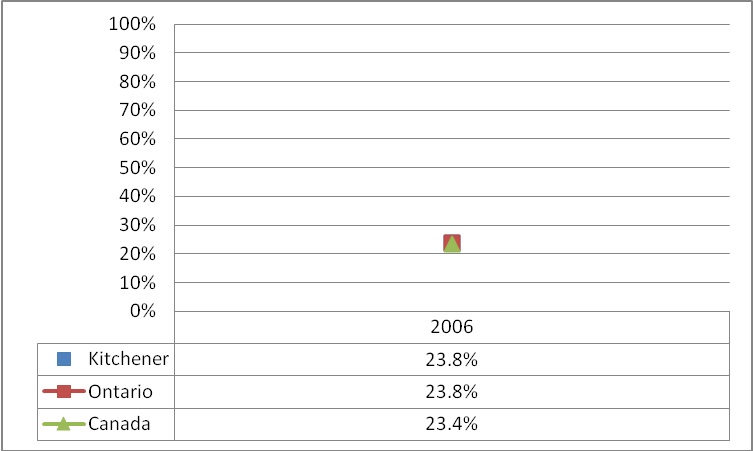
 Data Source: Ontario Early Years Centre, A Community Fit for Children Report (Released Every Three Years)
Data Source: Ontario Early Years Centre, A Community Fit for Children Report (Released Every Three Years)